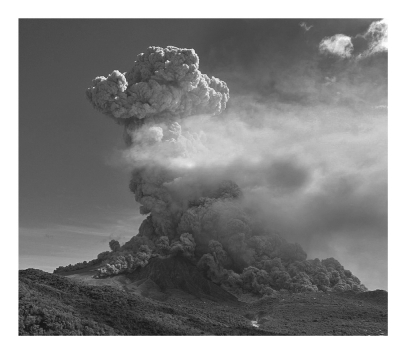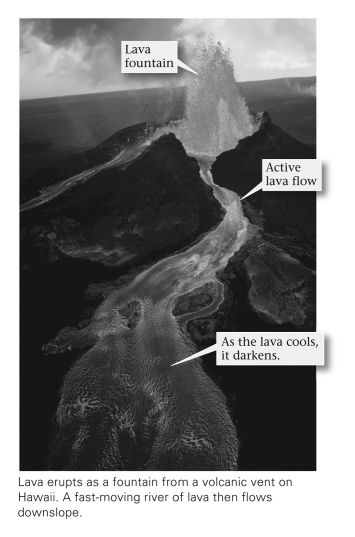A) are completely devoid of volatiles and thus travel slowly
B) erupt underwater and thus cool very quickly
C) are highly felsic and thus travel slowly
D) are ultramafic and thus freeze at exceptionally high temperatures
F) All of the above
Correct Answer

verified
Correct Answer
verified
Multiple Choice
As compared to mafic igneous rocks,all felsic igneous rocks ____________.
A) cool and solidify more quickly
B) cool and solidify more slowly
C) solidify at higher temperatures
D) solidify at lower temperatures
F) All of the above
Correct Answer

verified
Correct Answer
verified
Multiple Choice
When rock is partially melted,the chemistry of the melt is ____________.
A) more mafic than the original chemistry of the rock that was partially melted
B) more felsic than the original chemistry of the rock that was partially melted
C) identical to the original chemistry of the rock that was partially melted
D) completely unpredictable (it could be more mafic or more felsic)
F) B) and D)
Correct Answer

verified
Correct Answer
verified
Multiple Choice
Viscosity depends on ____________.
A) temperature
B) volatile content
C) silica content
D) All of the above are correct.
F) All of the above
Correct Answer

verified
Correct Answer
verified
Multiple Choice
Bowen's continuous reaction series describes the crystallization behavior of a single mineral (with variable chemical composition) ,____________.
A) olivine
B) plagioclase
C) pyroxene
D) quartz
F) All of the above
Correct Answer

verified
Correct Answer
verified
Multiple Choice
A majority of the melts in the Earth form through the partial melting of ultramafic mantle rock.These newly formed magmas are ____________.
A) ultramafic
B) mafic
C) felsic
D) intermediate
F) A) and B)
Correct Answer

verified
Correct Answer
verified
Multiple Choice
Volatiles refer to substances that ____________.
A) crystallize most rapidly out of a melt
B) melt immediately upon contact with a hot body of magma
C) have a tendency to evaporate and are stable as gases
E) None of the above
Correct Answer

verified
Correct Answer
verified
Multiple Choice
Geologically,melts are equivalent to both ____________ and ____________.
A) felsic magma; mafic magma
B) felsic lava; mafic lava
C) lavas; magmas
D) fine-grained igneous rocks; coarse-grained igneous rocks
F) A) and D)
Correct Answer

verified
Correct Answer
verified
Multiple Choice
Bombs,ash,and cinders are all examples of ____________. 
A) intrusive igneous rocks
B) hot spots
C) volatiles
D) pyroclastic debris
F) A) and D)
Correct Answer

verified
Correct Answer
verified
Multiple Choice
A volcanic neck,such as that seen at Shiprock,New Mexico (below) ,is a(n) ____________. 
A) sheet-like intrusion that lies parallel to surrounding layers of sedimentary rock
B) cooled layer of lava
C) intrusion formed within a volcano
D) sheet-like intrusion that cuts across preexisting layers
F) C) and D)
Correct Answer

verified
Correct Answer
verified
Multiple Choice
A volcanic island arc occurs at ____________.
A) the Aleutian Islands of Alaska
B) the Andes Mountains
C) Hawaii
D) Mt. St. Helens, Washington
F) C) and D)
Correct Answer

verified
Correct Answer
verified
Multiple Choice
Vesicles is a term used mostly to describe a texture in __________ igneous rocks.
A) crystalline
B) glassy
C) pyroclastic
E) A) and C)
Correct Answer

verified
Correct Answer
verified
Multiple Choice
If you determine the composition of an igneous rock,you can deduce a number of things about the rock's origin.Which one of these is NOT one of those things?
A) the rate at which it cooled
B) the environment in which it formed
C) the original source of the magma
D) the exact age of the rock
F) A) and D)
Correct Answer

verified
Correct Answer
verified
Multiple Choice
The geotherm is the rate of change of ____________.
A) pressure with depth in Earth's interior
B) temperature with depth in Earth's interior
C) temperature with altitude in Earth's atmosphere
D) temperature with latitude on Earth's surface
F) None of the above
Correct Answer

verified
Correct Answer
verified
Multiple Choice
Why don't all igneous rocks contain all the minerals listed in Bowen's Reaction Series?
A) Minerals degrade with time, leaving only some of the series behind in igneous rocks.
B) Crystallization may be complete before all of the minerals in the series have had time to form.
C) Not all of the minerals in the series have the ability to form in every rock.
D) Bowen's Reaction Series only applies to some igneous rocks, not all.
F) A) and C)
Correct Answer

verified
Correct Answer
verified
Multiple Choice
A famous example of hot-spot volcanism occurs at ____________.
A) the Aleutian Islands of Alaska
B) the Andes Mountains
C) the island of Hawaii
D) Mt. St. Helens, Washington
F) None of the above
Correct Answer

verified
Correct Answer
verified
Multiple Choice
The difference between lava and magma is that magma ____________. 
A) is light in color, whereas lava is dark
B) usually has mafic composition, whereas lava usually has felsic composition
C) is found beneath Earth's surface, whereas lava has reached the surface
D) flows more quickly than lava
F) None of the above
Correct Answer

verified
Correct Answer
verified
Multiple Choice
An igneous rock with a mixed texture of coarse grains (phenocrysts) surrounded by fine crystals (groundmass) is termed ____________.
A) porphyritic
B) phaneritic
C) aphanitic
D) necrotic
F) C) and D)
Correct Answer

verified
Correct Answer
verified
Multiple Choice
Which of the following would help distinguish continental hot spots from oceanic hot spots?
A) the presence of water
B) the presence of both mafic and felsic magmas
C) the presence of other, extinct or active, volcanoes nearby
D) the presence of basalt
F) A) and C)
Correct Answer

verified
Correct Answer
verified
Multiple Choice
Stoping by magmas occurs when ____________.
A) pieces of surrounding country rock are broken off and assimilated
B) the magma stops flowing and starts to solidify
C) the magma becomes fully solidified to form intrusive rock
D) the magma alters a thin rind of surrounding country rock
F) None of the above
Correct Answer

verified
Correct Answer
verified
Showing 21 - 40 of 64
Related Exams